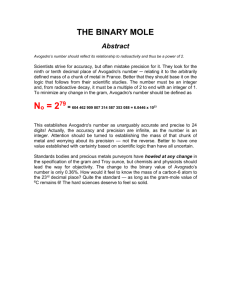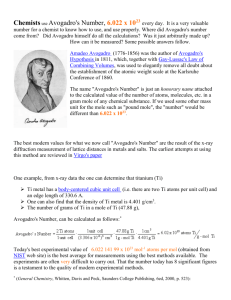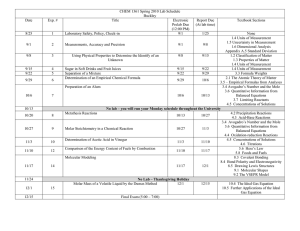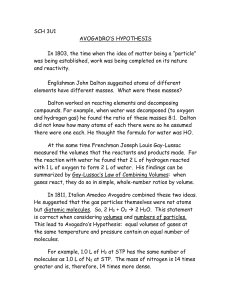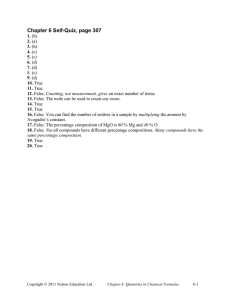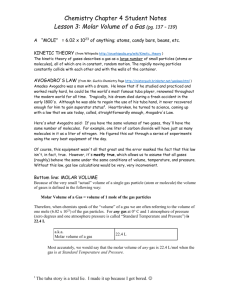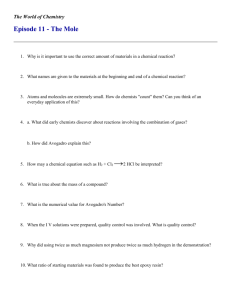Avogadro`s Constant
advertisement
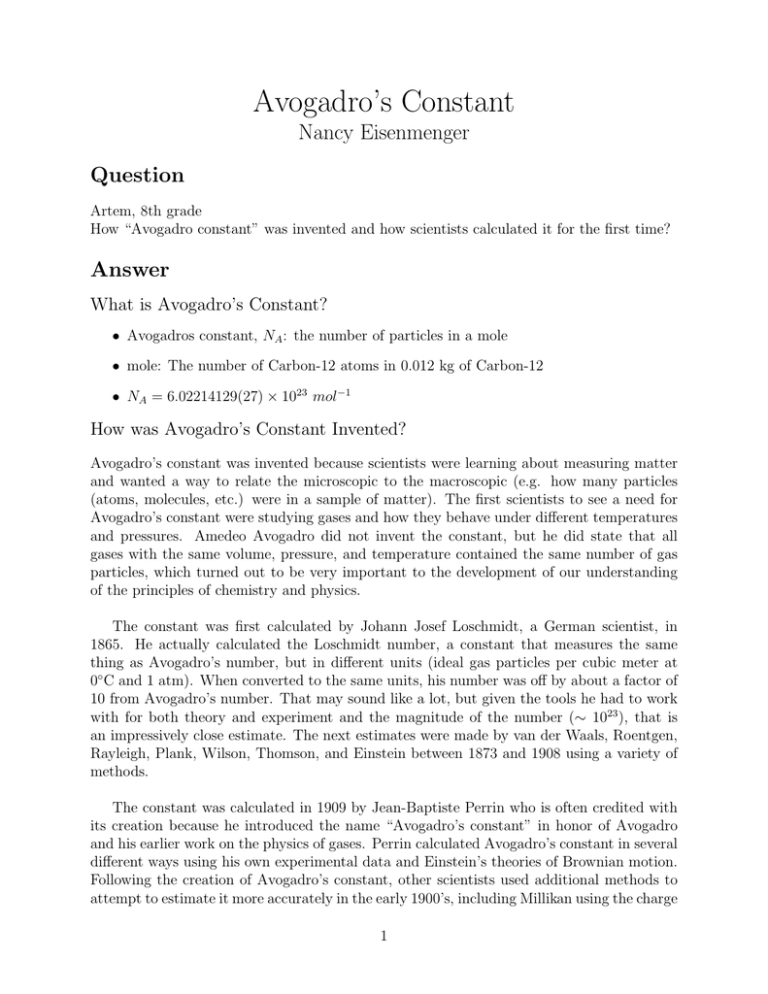
Avogadro’s Constant Nancy Eisenmenger Question Artem, 8th grade How “Avogadro constant” was invented and how scientists calculated it for the first time? Answer What is Avogadro’s Constant? • Avogadros constant, NA : the number of particles in a mole • mole: The number of Carbon-12 atoms in 0.012 kg of Carbon-12 • NA = 6.02214129(27) × 1023 mol−1 How was Avogadro’s Constant Invented? Avogadro’s constant was invented because scientists were learning about measuring matter and wanted a way to relate the microscopic to the macroscopic (e.g. how many particles (atoms, molecules, etc.) were in a sample of matter). The first scientists to see a need for Avogadro’s constant were studying gases and how they behave under different temperatures and pressures. Amedeo Avogadro did not invent the constant, but he did state that all gases with the same volume, pressure, and temperature contained the same number of gas particles, which turned out to be very important to the development of our understanding of the principles of chemistry and physics. The constant was first calculated by Johann Josef Loschmidt, a German scientist, in 1865. He actually calculated the Loschmidt number, a constant that measures the same thing as Avogadro’s number, but in different units (ideal gas particles per cubic meter at 0◦ C and 1 atm). When converted to the same units, his number was off by about a factor of 10 from Avogadro’s number. That may sound like a lot, but given the tools he had to work with for both theory and experiment and the magnitude of the number (∼ 1023 ), that is an impressively close estimate. The next estimates were made by van der Waals, Roentgen, Rayleigh, Plank, Wilson, Thomson, and Einstein between 1873 and 1908 using a variety of methods. The constant was calculated in 1909 by Jean-Baptiste Perrin who is often credited with its creation because he introduced the name “Avogadro’s constant” in honor of Avogadro and his earlier work on the physics of gases. Perrin calculated Avogadro’s constant in several different ways using his own experimental data and Einstein’s theories of Brownian motion. Following the creation of Avogadro’s constant, other scientists used additional methods to attempt to estimate it more accurately in the early 1900’s, including Millikan using the charge 1 of electrons, Rutherford using measurements of radioactivity from Radium, and Nuoy using molecular monolayers on liquids. The modern method of determining the constant uses x-ray diffraction to measure the distances between atoms in a crystal. How do you measure the Avogadro Constant? 1. Loschmidt, van der Waals and The Kinetic Theory of Gases Loschmidt estimated the size and number density of gas particles using the kinetic molecular theory of gases with the concept of the mean free path. The mean free path is the distance a particle travels before colliding with another particle. The mean free path of particles is related to the size and number density of the particles. The equation for the mean free path, `, can be written as: `= 3 4n0 πd2 (1) where d is the diameter of the molecules and n0 is the number density (number of particles per volume) of particles. Loschmidt measured the mean free path of air by studying diffusion. He estimated the size of the gas particles in air as 1 nanometer.1 With that information, he could calculate the number density by solving for n0 . This value of n0 is the Loschmidt number (NL ) and is related to the Avogadro constant. 2. Einstein, Perrin and Statistical Mechanics of Brownian Motion Perrin calculated the Avogadro constant in three ways, using: (a) the exponential distribution of particles with gravity, (b) measurement of Brownian movement and the diffusion constant, (c) measurement of rotational motion in Brownian systems. (a) The distribution of particles in a fluid in a gravitational field is governed by a special case of the Boltzmann distribution called the “barometric distribution.” Essentially this equation says that gravity will cause more particles to be closer to the bottom and fewer particles to be closer to the top. The the distribution, P of particles as a function of height, h is P (h) = P (h0 )e−mg(h−h0 )/kB T (2) where h0 is a reference height, m is the particle mass, g is the gravitational constant, T is the absolute temperature, and kB is the Boltzmann constant. By measuring the exponential distribution of small spherical particles dispersed in liquid, Perrin was able to calculate a value for the Boltzmann constant and relate it to the Avogadro constant by the gas constant, R (NA = R/kB ). 1 Loschmidt did not have a way to directly measure the size of an air molecule (or any other molecules) so he had to find a clever way to estimate the size. He estimated that the size of a particle was related to the mean free path length and its “condensation coefficient” (the ratio of the volume of the liquid to the volume of the gas). Since he could not measure this ratio for air, he had to extrapolate (estimate based on a trend) it from the “condensation coefficients” of other known compounds. Using the estimated value, he calculated the size of an air molecule. 2 (b) The Brownian motion of a particle can be described using diffusion equations which describe how far the particle will move in a given amount of time. The movement of the particle is controlled by the diffusion constant, D. RT x¯2 =D= 2t 2πηrNA (3) The diffusion constant, D, can be determined by measuring the mean square displacement of the particle, x¯2 at time t. Using D and the gas constant, R, temperature, T , the viscosity of the fluid, η, and the particle radius, r, Perrin could calculate Avogadro’s constant. 3. Wilson, Thomson, Millikan and Electrons These scientists measured charged oil droplets suspended in an electric field and determined the charge of an electron which allowed them to calculate NA . 4. Rutherford and Radioactivity Rutherford used measurements of the radioactive decay of radium to calculate NA . 5. Roentgen, Rayleigh, Nouy and Molecular Layers on Liquids These scientists used measurements of molecular films on liquids to calculate the size of particles which they used in calculations of NA . 6. Bragg, Birge, Bearden, et. al. and X-ray Diffraction The most accurate way to-date to measure the Avogadro Constant is using x-ray diffraction. When x-rays pass through a crystal lattice, they are scattered in a predictable way. The scattering depends on the type of atoms, the arrangement of the atoms, and the spacing between them. By measuring the pattern of the scattered x-rays, scientists can reconstruct exactly how the atoms are arranged in the crystal and the distances between the atoms. With this very exact data, they can count how many atoms there are in a unit cell of the crystal, which gives them the number density (atoms/volume) of the material. Silicon crystals are the purest, most perfect crystals that we can make so they are used in measuring Avogadro’s constant. Given the atomic weight and mass density of silicon, the following equation can be used along with the x-ray crystal structure to calculate Avogadro’s constant nM 3 (4) a0 = ρNA where M is the molar mass (g/mol), n is the number of atoms in the unit cell, a30 is the unit cell volume (cm3 ), and ρ is the crystal density (g/cm3 ). 3 References: http://www.scientificamerican.com/article.cfm?id=how-was-avogadros-number http://iopscience.iop.org/0034-4885/64/12/206 (abstract) Becker, Peter. “History and progress in the accurate determination of the Avogadro Constant.” Reports on Progress in Physics. 64, (2001), 1945-2008. http://www.nobelprize.org/nobel_prizes/physics/laureates/1926/press.html http://assets.cambridge.org/97805218/11194/excerpt/9780521811194_excerpt.pdf http://pac.iupac.org/publications/pac/pdf/1992/pdf/6410x1535.pdf http://en.wikipedia.org/wiki/Brownian_motion http://www.chemteam.info/Chem-History/Loschmidt-1865.html http://en.wikipedia.org/wiki/Loschmidt_constant 4

